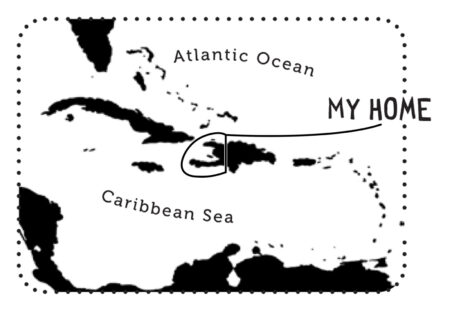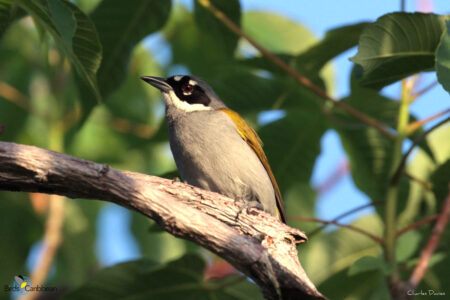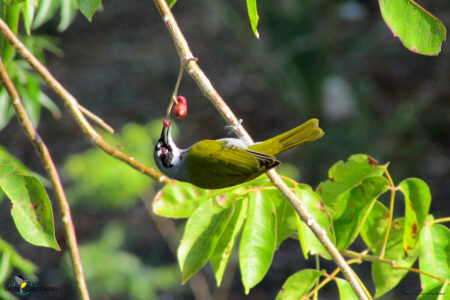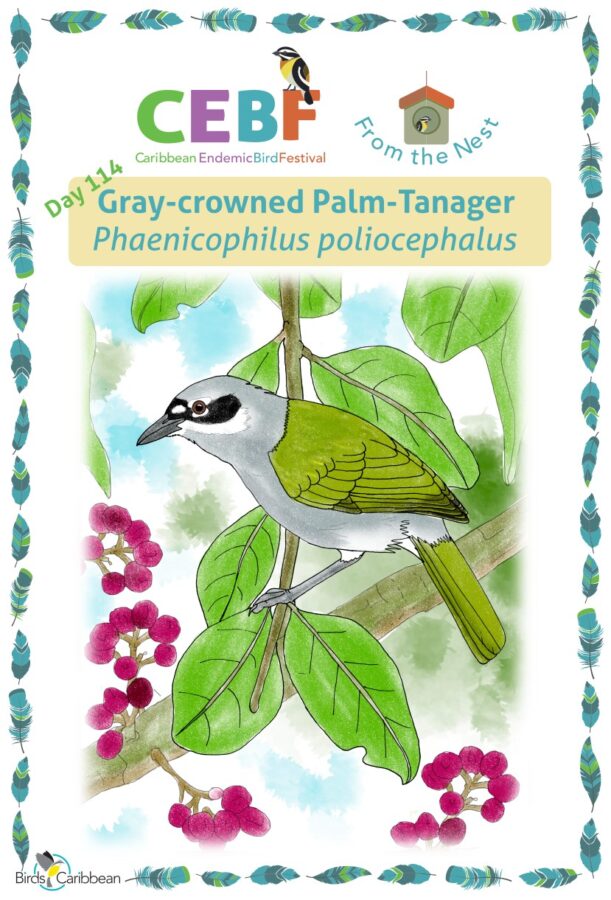Celebrate the Caribbean Endemic Bird Festival (CEBF) with us! Our theme in 2023 is “Water: Sustaining Bird Life,” highlighting the importance of water conservation to both humans and birds. Have fun learning about a new endemic bird every day. We have colouring pages, puzzles, activities, and more. Download for free and enjoy nature with your family at home.
Endemic Bird of the Day: Gray-crowned Palm-Tanager
Of all the endemic Hispaniolan birds, only one bears the title of being Haiti’s only endemic, and that is the lovely Gray-crowned Palm-Tanager. Found only in the western part of Haiti, it is counterpart to the more wide-spread Black-crowned Palm-Tanager, found throughout Hispaniola. This handsome bird is gray below with a gray crown and nape and yellow-green wings, back, and tail. Its black face mask contrasts sharply with broad white mustache stripes and three white spots around the eye, giving it a spectacled appearance and its common name of “four eyes” in Spanish and French, cuatro ojos or quatre-yeux.
The Gray-crowned Palm-Tanager can be distinguished from the similar Black-crowned Palm-Tanager, by, you guessed it, the namesake crown color. In addition, Gray-crowned Palm Tanagers have a white chin and gray throat, whereas the Black-crowned Palm Tanager has an entirely white throat.
But be wary of young Black-crowned Palm-Tanagers in the Sierra de Bahoruco population in the southwest of the Dominican Republic. These young birds will often have a black-gray mottled crown. So how else can we differentiate the two? Check the breast color, the Gray-crowned Palm-Tanagers not only have a gray crown but also a grayer breast, compared to the Black-crowned Palm-Tanager, whose breast is more grayish-white.
With these two birds being so similar, they’ve got to be related right? Correct – and actually it’s a pretty cool story also explaining a bit of the restricted range of the Gray-crowned Palm-Tanager. These birds are found west of the Jacmel Depression, a strip of land running north-south that separates the Tiburon Peninsula from the rest of Hispaniola. During the Mid Pleistocene (circa 1 million years ago) the Jacmel Depression was so low, it was actually underwater, making the Massif de la Hotte mountain range on the Tiburon Peninsula effectively isolated from the rest of Hispaniola. This isolation is what allowed for the speciation of the Gray-crowned Palm-Tanager. And it’s speculated that this geographic barrier led to the speciation of many other flora and fauna, much of which has yet to be described to science!
Though very range restricted, within the Tiburon Peninsula, the Gray-crowned Palm-Tanager is actually fairly common, being found in forests from the coast up to 2,400m elevation. They have been found inhabiting mangrove forests, city parks, coastal scrub, agro-forestry plantations, pine forest, semi-humid forest, and humid forest. Though they are especially abundant in the Macaya Biosphere Reserve, a national park high up in the Massif de la Hotte mountains. Like their black-crowned counterpart, these birds are also generalists, feeding on ripe fruits and probing dead leaves for arthropods.
While the Gray-crowned Palm-Tanager is considered common, especially in comparison to many other Haitian birds, they are still of conservation concern. Only 1.5% of Haiti’s original forest cover remains, and even this continues to face the threat of encroaching agriculture and charcoal production for cooking. Their small range and lack of any conservation enforcement means conserving what little remains of the Tiburon Peninsula should be a top conservation priority to ensure the survival of these unique birds as well as other species waiting to be discovered.. Learn more about this species, including its range, photos, and calls here.
Colour in the Gray-crowned Palm-Tanager
Download our West Indies Endemic Bird colouring page. Use the photos below as your guide, or you can look up pictures of the bird online or in a bird field guide if you have one. Share your coloured-in page with us by posting it online and tagging us @BirdsCaribbean #CEBFfromthenest
Listen to the call of the Gray-crowned Palm-Tanager
The call of the Gray-crowned Palm-Tanager is a thin “Peee-u“.
Puzzle of the Day
Click on the image below to do the puzzle. You can make the puzzle as easy or as hard as you like – for example, 6, 8, or 12 pieces for young children, all the way up to 1,024 pieces for those that are up for a challenge!


Activity of the Day
FOR KIDS AND ADULTS: This activity is for everyone! The Gray-crowned Palm-Tanager is endemic to Haiti, part of the island of Hispaniola. It’s time to get creative and learn to draw two other beautiful endemic birds from Hispaniola. The similar looking Black-crowned Palm Tanager, who lives ‘next door’ in the Dominican Republic and another the Hispaniolan Lizard Cuckoo (found across Hispaniola). Grab some paper and your colouring pencils and get ready to draw along with artist Josmar Esteban Marquez!
Then, enjoy this video of a Gray-crowed Palm-Tanager in the wild!

